ADVENTURES IN ARCHITECTURE: THE SERIES
Il Duomo: Brunelleschi and the Dome of Santa Maria del Fiore
Episode 12: The Journey Today
by Jim Atkins, FAIA, FKIA
Illustrations by Jim Anderson
Summary: In this last and final episode, we are privileged to accompany author Jim Atkins, FAIA, FKIA, as we return to Florence. Only this time, it will be in the 21st century. We will visit the dome as it exists today, a significant tourist attraction that has not lost its grandeur or its intrigue. For six centuries it has endured earthquakes, foundation movement, lightning strikes, and the wear of millions of happy feet making their way up the seemingly endless stairs to the top of Il Duomo. Let the climbing begin!
In our last episode, we returned to the 15th century where we followed the construction of the magnificent lantern that adorns the top of the dome of the Basilica of Santa Maria del Fiore. Unfortunately, the great Brunelleschi did not live to see his lantern completed. Work had only begun when he became ill suddenly and passed away.
Friend and foe alike mourned his passing, and he was laid to rest in a crypt beneath the south aisle of the Basilica, an honor reserved only for distinguished people. Interestingly, the crypt was not marked, and its location was forgotten for centuries until it was rediscovered in 1972 during forensic excavations. Filippo’s adopted son, Andrea il Buggiano, an accomplished artist himself, would later carve a marble bust of Brunelleschi to be placed in the cathedral as a memorial.
Today, the great dome of Santa Maria del Fiore is known as Brunelleschi’s dome. It is fitting that our man receives this honor, since the dome would likely not be what it is today without his ingenious designs and inventive skills, if it would exist at all. And one cannot visit Piazza del Duomo today without seeing or hearing the name Brunelleschi. He basically owns the place.
In this last and final episode we will again return to Florence, only this time it will be in the 21st century. We will visit the dome as it exists today, a significant tourist attraction that has not lost its grandeur or its intrigue. For six centuries it has endured earthquakes, foundation movement, lightning strikes, and the wear of millions of happy feet making their way up the seemingly endless stairs to the top of Il Duomo.
The visit
The day is September 1, 2007, and my wife, Dr. Sook Kim, and I have just arrived in Florence by train from Pisa, where we had visited the world’s most famous construction defect. After arriving in Florence, we walk from the train station down Via dei Panzani and turn left onto Via de Cerretani.
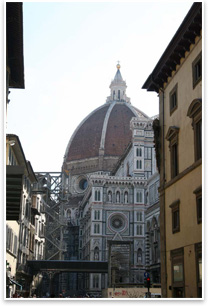 It is the same route taken by Pope Eugene IV in 1436 during the consecration of the Basilica. As we work our way toward Piazza del Duomo, the great dome comes into view above the buildings at the end of the narrow street. Our hearts race as we anticipate climbing the 463 steps to the top of the dome to view the magnificent city of Florence and see firsthand the great triumph of Filippo Brunelleschi. It is the same route taken by Pope Eugene IV in 1436 during the consecration of the Basilica. As we work our way toward Piazza del Duomo, the great dome comes into view above the buildings at the end of the narrow street. Our hearts race as we anticipate climbing the 463 steps to the top of the dome to view the magnificent city of Florence and see firsthand the great triumph of Filippo Brunelleschi.
(note: used in previous episode)
View of Il Duomo From Via de Cerretani
Join us now as we experience the dome as it exists today. Walk with us up the narrow stairways and through the labyrinth of spaces between the two dome shells. Emerge with us at the base of the lantern to see the fabulous Florentine cityscape that has so masterfully endured the last six centuries. Breathe the Florentine air with us in this last and final episode of Il Duomo.
The passage
There are four sets of stairs from ground level to the top of the tambour. They rise through the four great piers that support the dome. The stairs were a part of the original construction, and the workers in the 15th century used them to access their work on the dome. Two were used for ascent and two for descent to avoid opposing traffic in the narrow passageways. Entry to the lantern today is gained through the passage at the northwestern pier. Tourists enter from a side door and purchase tickets before ascending the stairs.
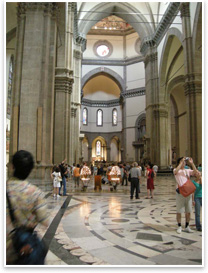 It is mid-afternoon on Saturday, and the crowd purchasing tickets at the window is relatively light. As we step into the coolness of the great cathedral, the magnificent space towers above us, its power and presence almost overwhelming. We stop to look at the lofty vaulting and intricate tracery of the stained glass windows. From our position we can see the transept beneath the dome and part of Vasari’s famous fresco overhead. Searching for words to describe this great experience, we can only think of what our daughter Ashley would likely say: “Totally awesome!” It is mid-afternoon on Saturday, and the crowd purchasing tickets at the window is relatively light. As we step into the coolness of the great cathedral, the magnificent space towers above us, its power and presence almost overwhelming. We stop to look at the lofty vaulting and intricate tracery of the stained glass windows. From our position we can see the transept beneath the dome and part of Vasari’s famous fresco overhead. Searching for words to describe this great experience, we can only think of what our daughter Ashley would likely say: “Totally awesome!”
Interior of Basilica Looking Toward the Dome
We take a parting look at the cathedral interior before ascending the stairs and entering the door into the passageway enclosed by the pier. Above the door is the emblem of the Guild of Wool Merchants. The stairway rises to our right, and we begin our ascent upward.
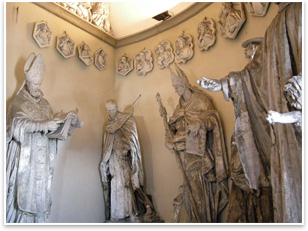 The first stair rises to an open room above the northeastern apse. The room is filled with statuary; copies of existing works. I couldn’t help but wonder how difficult it must have been to get the large pieces up the narrow stairway to the room. The first stair rises to an open room above the northeastern apse. The room is filled with statuary; copies of existing works. I couldn’t help but wonder how difficult it must have been to get the large pieces up the narrow stairway to the room.
Statuary in the Northeastern Apse
From that room we enter a narrow hallway and up a spiral stair with deep risers, climbing counter-clockwise upward. (Brunelleschi wanted descent to be in a clockwise direction to make it easier on the workers descending from the dome at the end of the work day.)
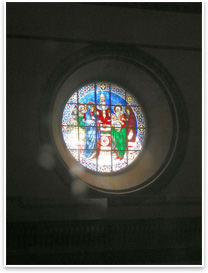 The surge of the group behind urges us to move more quickly, imposing aerobics that we had not anticipated. As we become winded and start to wonder just how high we will have to climb, we come upon and enter the first of two balconies in the drum; this one just below the large round windows of the tambour. The surge of the group behind urges us to move more quickly, imposing aerobics that we had not anticipated. As we become winded and start to wonder just how high we will have to climb, we come upon and enter the first of two balconies in the drum; this one just below the large round windows of the tambour.
A Round Stained Glass Window in the Tambour
Vasari’s Fresco: The Coming of Christ
We walk out on the narrow balcony, where clear acrylic barriers have been installed to prevent people from falling over the low handrail. The enclosure is narrow, and somewhat claustrophobic, but the dome overhead proves liberating. Above us towers the panorama of Vasari’s great fresco, The Coming of Christ. We are awestruck at the greatness of the work and its profound and shocking contents; no doubt intended to strike fear in the people who view it.
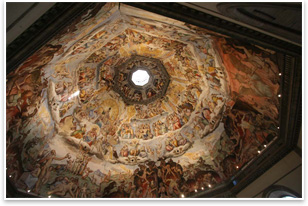 Vasari’s Fresco: The Coming of Christ Vasari’s Fresco: The Coming of Christ
As Seen From the Lower Balcony
At the top of the fresco are God and Jesus with the 12 disciples, looking down at the righteous who have escaped hell and are climbing toward heaven. Below them are devils inflicting great horror to those not deserving of ascension. The work is quite intricate, with much detail. I visualize Vasari spending days on his back on the scaffolding, painting this elaborate visage. Such undertakings were not rare in that time, as Michelangelo would do the same 140 miles away in Rome on the ceiling of the Sistine Chapel a relatively short time later. (Only his work was not done 375 feet above the hard stone floor.)
The exit door from the balcony is on the opposite side of the dome from the entry door, and we work our way around the narrow balcony, following the line of tourists as we gaze overhead in awe of the great artistry above us.
Traversing the two domes
The exit from the lower balcony leads to yet another spiral stair, but its vertical distance is much shorter than the one below. After a bit more climbing, we enter the cavity between the two domes, where the stairs continue upward along the circumference, curving with the shape of the dome.
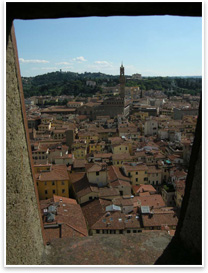 As the stairs continue upward, we encounter windows that afford magnificent views of Florentine rooftops and city streets far below. The unique vantage point gives us a feeling of superiority, perched high above all of Florence. I can feel the power of the place and its dominance on the city. I can’t help but wonder if Brunelleschi actually envisioned and planned this magnificent effect before the stones were placed, or if he only discovered it as we are doing after it was constructed. You can probably guess what his answer would be. Each visage provides a unique and wonderful view of the city below. As the stairs continue upward, we encounter windows that afford magnificent views of Florentine rooftops and city streets far below. The unique vantage point gives us a feeling of superiority, perched high above all of Florence. I can feel the power of the place and its dominance on the city. I can’t help but wonder if Brunelleschi actually envisioned and planned this magnificent effect before the stones were placed, or if he only discovered it as we are doing after it was constructed. You can probably guess what his answer would be. Each visage provides a unique and wonderful view of the city below.
Small Dome Window
We soon encounter tourists descending the same stairs that we are ascending. We are forced to synchronize our movements, as the stairs are too narrow to easily pass each other. One group waits in a wider space while a few of the other group passes, alternating until both groups have passed. We soon realize that this is the only route available from this point upward to the top of the dome.
 We continue climbing and come upon a straight set of stairs that go directly upward in an arch, and we realize that we are ascending over the very top of the dome itself to the oculus. We look down at the steps let into the form of the lower dome. We realize that we are actually walking on the lower dome structure and we will soon reach the lantern. Our excitement builds as we realize that we are almost there. We continue climbing and come upon a straight set of stairs that go directly upward in an arch, and we realize that we are ascending over the very top of the dome itself to the oculus. We look down at the steps let into the form of the lower dome. We realize that we are actually walking on the lower dome structure and we will soon reach the lantern. Our excitement builds as we realize that we are almost there.
Stair over the Top of the Dome
When we reach the top of the stairway, to our left there is a steep stair, like a ship’s ladder, leading to a roof hatch at the base of the lantern. We climb the ladder, and as we enter through the hatch, the sunlight overcomes us, and as our eyes adjust, we can see the beautiful city of Florence below in all directions. We have finally reached the pinnacle of Il Duomo.
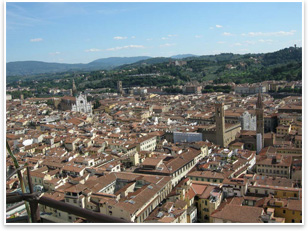 View of Florence From the Lantern View of Florence From the Lantern
The lantern and Florence
I am overcome with emotion as I scramble onto the lantern floor. Here I am, at the summit of Brunelleschi’s dream. I have actually scaled the building that this great mind conceived and constructed six centuries ago. It is this physical manifestation of his dream that now allows me to appreciate fully this magnificent work of art and architecture.
As I emerge into the bright sunlight, surrounded by other tourists who fill up the base of the lantern, I look out upon the city of Florence, and I can’t help myself; I am overcome with excitement as I shout, “Bravo Brunelleschi!”
The tourists suddenly stop and look at me quizzically, as if someone has suddenly interrupted their experience. I look around at the silent, intent faces staring back at me, and I realize that they may not be sharing the same level of ecstasy as I am.
But it doesn’t matter, it is only what each person gets from it. As the easygoing Italians would put it, a ciascuno il suo, or to each his own. I look out across the beautiful city of Florence, and to me it appears no different from the time of Filippo. I imagine that I am his post-Medieval associate—for a few seconds, I become an architect in the1400s. As I breathe the Florentine air and I look down upon the great city below me, for a few seconds, I too am a Renaissance architect.
This is without question one of the most enjoyable and fulfilling experiences of my life.
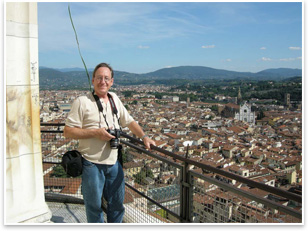 The Author on Il Duomo The Author on Il Duomo
Some final words
This great treasure remains today, available for the architects of the world—or anyone interested in the Renaissance and its cathedrals—to visit and explore. It is a place that brings excitement to everyone. Florence is wonderful, and the Italians are among the most friendly and hospitable people I have had the pleasure to meet and mingle with in my travels. They own and maintain some of the truly great architecture of the world, and the treasure of Il Duomo is among the most magnificent. If you travel to Europe, you will be prudent not to miss it.
This little man, Filippo de sur de lapo Brunelleschi, who had departed from his father’s wishes for him to become a notary, became one of the most profound and prolific inventors and designers of the Renaissance. Toiling in the rancid foundries and studying the architecture and construction of Rome, his self-education honed and prepared him for the masterworks he created in his later life.
From my perspective, his accomplishments go beyond the inventions of Leonardo di Vinci, and his designs and artistry surpass the great Michelangelo, because he did so much—with so much less. He was a humble person skilled in the technical arts. He was an average man who sought and achieved greatness, all the while living a somewhat average lifestyle. He was someone whom any one of us can aspire to be, if only we want it badly enough and are willing to give what it takes to get it. These attributes, and the amazing results of his artistry are what make Filippo Brunelleschi one of the greatest inventors and architects who ever lived.
And so ends the tale of Il Duomo and the great Brunelleschi. I hope you have enjoyed my observations on this great architect over this past year as much as I have enjoyed expressing them. If you have an interest in this little genius, the resources abound and his constructed work still exists. For I have only scratched the surface.
Until next time, I wish you good luck out there.
|


 It is the same route taken by Pope Eugene IV in 1436 during the consecration of the Basilica. As we work our way toward Piazza del Duomo, the great dome comes into view above the buildings at the end of the narrow street. Our hearts race as we anticipate climbing the 463 steps to the top of the dome to view the magnificent city of Florence and see firsthand the great triumph of Filippo Brunelleschi.
It is the same route taken by Pope Eugene IV in 1436 during the consecration of the Basilica. As we work our way toward Piazza del Duomo, the great dome comes into view above the buildings at the end of the narrow street. Our hearts race as we anticipate climbing the 463 steps to the top of the dome to view the magnificent city of Florence and see firsthand the great triumph of Filippo Brunelleschi. It is mid-afternoon on Saturday, and the crowd purchasing tickets at the window is relatively light. As we step into the coolness of the great cathedral, the magnificent space towers above us, its power and presence almost overwhelming. We stop to look at the lofty vaulting and intricate tracery of the stained glass windows. From our position we can see the transept beneath the dome and part of Vasari’s famous fresco overhead. Searching for words to describe this great experience, we can only think of what our daughter Ashley would likely say: “Totally awesome!”
It is mid-afternoon on Saturday, and the crowd purchasing tickets at the window is relatively light. As we step into the coolness of the great cathedral, the magnificent space towers above us, its power and presence almost overwhelming. We stop to look at the lofty vaulting and intricate tracery of the stained glass windows. From our position we can see the transept beneath the dome and part of Vasari’s famous fresco overhead. Searching for words to describe this great experience, we can only think of what our daughter Ashley would likely say: “Totally awesome!” The first stair rises to an open room above the northeastern apse. The room is filled with statuary; copies of existing works. I couldn’t help but wonder how difficult it must have been to get the large pieces up the narrow stairway to the room.
The first stair rises to an open room above the northeastern apse. The room is filled with statuary; copies of existing works. I couldn’t help but wonder how difficult it must have been to get the large pieces up the narrow stairway to the room. The surge of the group behind urges us to move more quickly, imposing aerobics that we had not anticipated. As we become winded and start to wonder just how high we will have to climb, we come upon and enter the first of two balconies in the drum; this one just below the large round windows of the tambour.
The surge of the group behind urges us to move more quickly, imposing aerobics that we had not anticipated. As we become winded and start to wonder just how high we will have to climb, we come upon and enter the first of two balconies in the drum; this one just below the large round windows of the tambour. Vasari’s Fresco: The Coming of Christ
Vasari’s Fresco: The Coming of Christ As the stairs continue upward, we encounter windows that afford magnificent views of Florentine rooftops and city streets far below. The unique vantage point gives us a feeling of superiority, perched high above all of Florence. I can feel the power of the place and its dominance on the city. I can’t help but wonder if Brunelleschi actually envisioned and planned this magnificent effect before the stones were placed, or if he only discovered it as we are doing after it was constructed. You can probably guess what his answer would be. Each visage provides a unique and wonderful view of the city below.
As the stairs continue upward, we encounter windows that afford magnificent views of Florentine rooftops and city streets far below. The unique vantage point gives us a feeling of superiority, perched high above all of Florence. I can feel the power of the place and its dominance on the city. I can’t help but wonder if Brunelleschi actually envisioned and planned this magnificent effect before the stones were placed, or if he only discovered it as we are doing after it was constructed. You can probably guess what his answer would be. Each visage provides a unique and wonderful view of the city below. We continue climbing and come upon a straight set of stairs that go directly upward in an arch, and we realize that we are ascending over the very top of the dome itself to the oculus. We look down at the steps let into the form of the lower dome. We realize that we are actually walking on the lower dome structure and we will soon reach the lantern. Our excitement builds as we realize that we are almost there.
We continue climbing and come upon a straight set of stairs that go directly upward in an arch, and we realize that we are ascending over the very top of the dome itself to the oculus. We look down at the steps let into the form of the lower dome. We realize that we are actually walking on the lower dome structure and we will soon reach the lantern. Our excitement builds as we realize that we are almost there. View of Florence From the Lantern
View of Florence From the Lantern The Author on Il Duomo
The Author on Il Duomo